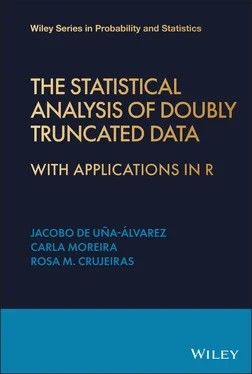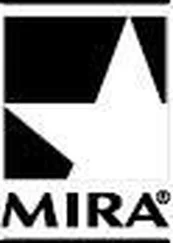Because of the interval sampling, the age at diagnosis  is doubly truncated by the pair
is doubly truncated by the pair  , where the right‐truncation variable
, where the right‐truncation variable  is the time in years from birth (date of onset,
is the time in years from birth (date of onset,  ) to 31 December 2003, and
) to 31 December 2003, and  . The
. The  triplets
triplets  ,
,  , with the values observed for
, with the values observed for  were reported in Moreira and de Uña‐Álvarez (2010), while de Uña‐Álvarez (2020) included the cancer group in the statistical analysis. Ordinary descriptive statistics can be applied to the information gathered along this 5 year long window to compute, for instance, the average age at cancer diagnosis. However, if the goal is to describe the population of children eventually developing cancer, the double truncation issue should be acknowledged and properly corrected, so potential biases are avoided.
were reported in Moreira and de Uña‐Álvarez (2010), while de Uña‐Álvarez (2020) included the cancer group in the statistical analysis. Ordinary descriptive statistics can be applied to the information gathered along this 5 year long window to compute, for instance, the average age at cancer diagnosis. However, if the goal is to describe the population of children eventually developing cancer, the double truncation issue should be acknowledged and properly corrected, so potential biases are avoided.
Interestingly, the observed values for  range between
range between  and 14.5 (years); equivalently, the observed values for
and 14.5 (years); equivalently, the observed values for  range between 0.5 and 19.5. This means that the lower and upper endpoints of
range between 0.5 and 19.5. This means that the lower and upper endpoints of  and
and  satisfy
satisfy  and
and  . Thus, in this case, the target variable
. Thus, in this case, the target variable  is observable on its whole support
is observable on its whole support  , and there are no identification issues for
, and there are no identification issues for  , the cdf of
, the cdf of  . Information on
. Information on  is summarized in Table 1.1.
is summarized in Table 1.1.
Table 1.1Descriptive statistics for Childhood Cancer Data: sample size  and mean (and standard deviation, SD) for the age at diagnosis (years).
and mean (and standard deviation, SD) for the age at diagnosis (years).
| Group |
|
 |
Mean (SD) |
| All |
|
406 |
6.47 (4.50) |
| By gender |
Female |
178 |
6.43 (4.51) |
|
Male |
228 |
6.51 (4.51) |
| By ICCC Group |
Leukemia |
107 |
6.30 (4.15) |
|
Lymphoma |
57 |
8.66 (4.39) |
|
N. System Tumour |
94 |
6.38 (4.29) |
|
Neuroblastoma |
38 |
3.16 (3.47) |
|
Other |
105 |
6.87 (4.70) |
|
Missing |
5 |
3.92 (5.18) |
This dataset is used in Chapters 2, 3and 5and is accessible in the DTDApackage in ChildCancer.
1.4.2 AIDS Blood Transfusion Data
Kalbfleish and Lawless (1989) reported 494 cases of transfusion‐related AIDS, corresponding to individuals diagnosed prior to 1 July 1986 (  ). The variable of ultimate interest
). The variable of ultimate interest  is the induction or incubation time, which is the time elapsed from HIV infection to AIDS. Importantly, HIV was unknown before 1982 (
is the induction or incubation time, which is the time elapsed from HIV infection to AIDS. Importantly, HIV was unknown before 1982 (  ); this implies that cases developing AIDS prior to this date were not reported. Let
); this implies that cases developing AIDS prior to this date were not reported. Let  denote the time from HIV infection to 1 July 1986 (in months), and introduce
denote the time from HIV infection to 1 July 1986 (in months), and introduce  ; then, due to the interval sampling, only triplets
; then, due to the interval sampling, only triplets  satisfying
satisfying  were observed (Bilker and Wang, 1996). We restrict our analysis to the
were observed (Bilker and Wang, 1996). We restrict our analysis to the  cases with consistent data, for which the infection could be attributed to a single transfusion or a short series of transfusions. This dataset is fully reported in Kalbfleish and Lawless (1989), p. 361.
cases with consistent data, for which the infection could be attributed to a single transfusion or a short series of transfusions. This dataset is fully reported in Kalbfleish and Lawless (1989), p. 361.
The observed values of  range from 0.5 to 89 (months), while
range from 0.5 to 89 (months), while  ranges from
ranges from  to 45.5. This suggests that the lower limit of the support of
to 45.5. This suggests that the lower limit of the support of  is about
is about  , while the upper limit of the support of
, while the upper limit of the support of  is about 99.5. As discussed in Chapter 2, in such a case the distribution of the incubation time
is about 99.5. As discussed in Chapter 2, in such a case the distribution of the incubation time  is identifiable on the interval
is identifiable on the interval  (months). The AIDS Blood Transfusion Data also includes information on the age of the individual at infection; see Table 1.2.
(months). The AIDS Blood Transfusion Data also includes information on the age of the individual at infection; see Table 1.2.
Читать дальше

 is doubly truncated by the pair
is doubly truncated by the pair  , where the right‐truncation variable
, where the right‐truncation variable  is the time in years from birth (date of onset,
is the time in years from birth (date of onset,  ) to 31 December 2003, and
) to 31 December 2003, and  . The
. The  triplets
triplets  ,
,  , with the values observed for
, with the values observed for  were reported in Moreira and de Uña‐Álvarez (2010), while de Uña‐Álvarez (2020) included the cancer group in the statistical analysis. Ordinary descriptive statistics can be applied to the information gathered along this 5 year long window to compute, for instance, the average age at cancer diagnosis. However, if the goal is to describe the population of children eventually developing cancer, the double truncation issue should be acknowledged and properly corrected, so potential biases are avoided.
were reported in Moreira and de Uña‐Álvarez (2010), while de Uña‐Álvarez (2020) included the cancer group in the statistical analysis. Ordinary descriptive statistics can be applied to the information gathered along this 5 year long window to compute, for instance, the average age at cancer diagnosis. However, if the goal is to describe the population of children eventually developing cancer, the double truncation issue should be acknowledged and properly corrected, so potential biases are avoided. range between
range between  and 14.5 (years); equivalently, the observed values for
and 14.5 (years); equivalently, the observed values for  range between 0.5 and 19.5. This means that the lower and upper endpoints of
range between 0.5 and 19.5. This means that the lower and upper endpoints of  and
and  satisfy
satisfy  and
and  . Thus, in this case, the target variable
. Thus, in this case, the target variable  is observable on its whole support
is observable on its whole support  , and there are no identification issues for
, and there are no identification issues for  , the cdf of
, the cdf of  . Information on
. Information on  is summarized in Table 1.1.
is summarized in Table 1.1. and mean (and standard deviation, SD) for the age at diagnosis (years).
and mean (and standard deviation, SD) for the age at diagnosis (years).
 ). The variable of ultimate interest
). The variable of ultimate interest  is the induction or incubation time, which is the time elapsed from HIV infection to AIDS. Importantly, HIV was unknown before 1982 (
is the induction or incubation time, which is the time elapsed from HIV infection to AIDS. Importantly, HIV was unknown before 1982 (  ); this implies that cases developing AIDS prior to this date were not reported. Let
); this implies that cases developing AIDS prior to this date were not reported. Let  denote the time from HIV infection to 1 July 1986 (in months), and introduce
denote the time from HIV infection to 1 July 1986 (in months), and introduce  ; then, due to the interval sampling, only triplets
; then, due to the interval sampling, only triplets  satisfying
satisfying  were observed (Bilker and Wang, 1996). We restrict our analysis to the
were observed (Bilker and Wang, 1996). We restrict our analysis to the  cases with consistent data, for which the infection could be attributed to a single transfusion or a short series of transfusions. This dataset is fully reported in Kalbfleish and Lawless (1989), p. 361.
cases with consistent data, for which the infection could be attributed to a single transfusion or a short series of transfusions. This dataset is fully reported in Kalbfleish and Lawless (1989), p. 361. range from 0.5 to 89 (months), while
range from 0.5 to 89 (months), while  ranges from
ranges from  to 45.5. This suggests that the lower limit of the support of
to 45.5. This suggests that the lower limit of the support of  is about
is about  , while the upper limit of the support of
, while the upper limit of the support of  is about 99.5. As discussed in Chapter 2, in such a case the distribution of the incubation time
is about 99.5. As discussed in Chapter 2, in such a case the distribution of the incubation time  is identifiable on the interval
is identifiable on the interval  (months). The AIDS Blood Transfusion Data also includes information on the age of the individual at infection; see Table 1.2.
(months). The AIDS Blood Transfusion Data also includes information on the age of the individual at infection; see Table 1.2.










